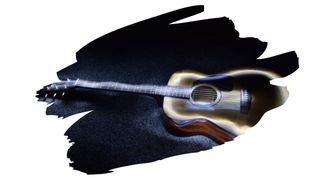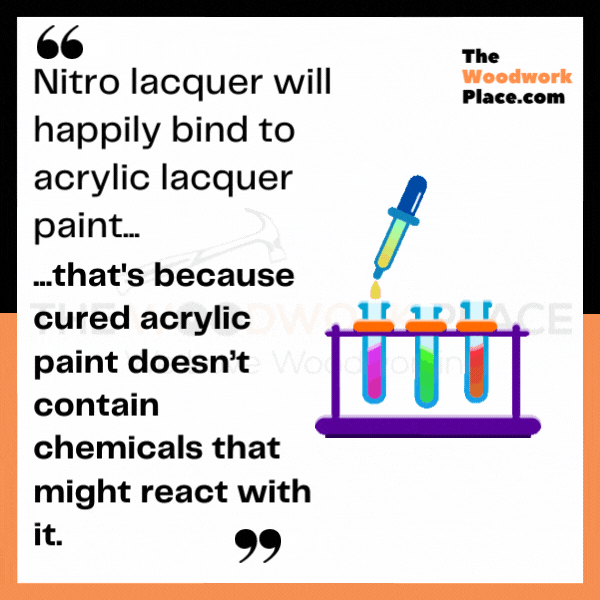How much does your type of finish change the tone of your guitar? A lot.
A light finish won’t impede the vibrations of tonewood, so they have less of an impact on sound. While, a heavier thicker finish can restrict vibration, lower resonance frequency, and in turn have an audibly greater impact.
This is one of the benefits of using a thin lightweight paint finish like lacquer. Whether it be nitro or acrylic, lacquer helps to protect, paint and finish a guitar – without much impacting the resonance of your instrument.
But, what if you want to add an additional coat of lacquer to an already lacquer-finished body? And will nitro lacquer even bind over acrylic in the first place?
Here’s the general problem with applying nitro lacquer over most finishes. Nitro lacquer is a solvent-based finish that does its best work on bare wood because it works by melting into the surface below.
This adhesion process is different to say an oil finish (which works by sinking into wood). Instead, nitro lacquer ‘burns’ into wood surfaces and base coats.
Which means, when we put nitro over most finishes – including coating it over another coat of nitro lacquer – the solvent content of nitro will react with the finish underneath it.
Related Post: The Top 3 Tru-oil Alternatives That’ll Give Your Guitar A Fine Finish
Acrylic lacquer, on the other hand, is a water-based lacquer. It doesn’t contain highly reactive solvents, and once it is wholly dry, it’ll adhere to another coat lacquer.
As long as that acrylic lacquer finish is dry, (we are talking bone-dry and cured here – no short cuts), then you can feel free to apply nitro lacquer onto it. The nitrocellulose finish won’t react with a dry water-based lacquer.
Plus, so long as you stick to applying very thin coats, that nitro lacquer won’t weigh things down either.
But, the trick to successfully binding these two lacquer types isn’t just about waiting for acrylic finish to dry. Its also about making sure you are working on a finish that is 100% acrylic…

This post may contain affiliate links to products that we receive a commission for (at no additional cost to you). Learn more here.
First Off, What’s The Difference Between Nitrocellulose Lacquer And Acrylic Lacquer?
The main difference between these two lacquers lies in their base ingredient.
Acrylic Lacquer is made up of acrylic resins that are contained inside a blended solution of water and pigments. This type of paint is usually used for doing automobile spot repairs.
Nitrocellulose main ingredient, however, is nitrocellulose. And nitrocellulose, (nitro for short), is used to bind the other ingredients in this lacquer, (ingredients such as sulphuric acid, mixed nitric and solvents).
Both lacquers rely on the process of evaporation to dry onto the surface of wood, metal, and the like. However, water will evaporate much faster than any solvent can.
So, in turn, acrylic lacquers will dry and cure a lot faster than nitro lacquer. It can take nitro lacquers weeks to cure, whilst taking an acrylic lacquer mere days to do the same.

Can You Use Nitrocellulose Lacquer Over Acrylic Lacquer Paint?
Nitro lacquer will happily bind to acrylic lacquer paint. This is because cured acrylic paint doesn’t contain thinners (like polyurethane) or other solvents that would react with a nitro top coat.
Related Post: Can You Put Tru Oil Over Nitro Lacquer? [Best Practice Revealed]
But, and this is very important, you need to be sure that acrylic coat is 100% acrylic – and not an acrylic lacquer that has been blended with something else.
Certain acrylic lacquer products are sometimes premixed with nitrocellulose lacquers, and other reactive additives, before they get brushed on.
In which case, if you were to apply nitro lacquer over a blended-acrylic-lacquer coated guitar, then you could end up with a ruined finish.

What Happens If You Put Nitro Over Nitro Lacquer?
Burning, melting, and generally an all-round ruined finish.
Nitro lacquers are their own worst enemy, in that they will react with any nitro lacquer that has been sprayed onto it.
Heck, even a bone-dry and cured nitro finish can begin to soften underneath a newly sprayed on layer of nitro.
Related Post: Don’t Put Nitro Lacquer Over That Polyurethane Finish [Here’s Why]
So To Sum Up…
Feel free to put nitro lacquer over acrylic. The nitro top coat won’t ruin things, provided you make sure of the following;
- That acrylic lacquer is wholly cured – not just dry (the curing process can take a few days to complete after application).
- And, the lacquer finish is 100% acrylic lacquer (and doesn’t contain other reactive chemicals in its blend).
References
Surface finishing by lacquer-coating technique – ScienceDirect
